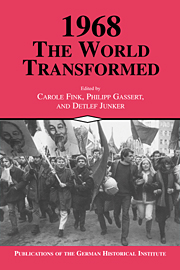Book contents
- Frontmatter
- Introduction
- Part One Tet and Prague: The Bipolar System in Crisis
- Part Two From Chicago to Beijing: Challenges to the Domestic Order
- Part Three “Ask the Impossible!”: Protest Movements of 1968
- 12 The Revolt Against the Establishment
- 13 The Changing Nature of the European Working Class
- 14 The Women's Movement in East and West Germany
- 15 1968: A Turning Point in American Race Relations?
- 16 The Revival of Holocaust Awareness in West Germany, Israel, and the United States
- 17 The Nuclear Threat Ignored
- Epilogue
- Index
12 - The Revolt Against the Establishment
Students Versus the Press in West Germany and Italy
Published online by Cambridge University Press: 05 January 2013
- Frontmatter
- Introduction
- Part One Tet and Prague: The Bipolar System in Crisis
- Part Two From Chicago to Beijing: Challenges to the Domestic Order
- Part Three “Ask the Impossible!”: Protest Movements of 1968
- 12 The Revolt Against the Establishment
- 13 The Changing Nature of the European Working Class
- 14 The Women's Movement in East and West Germany
- 15 1968: A Turning Point in American Race Relations?
- 16 The Revival of Holocaust Awareness in West Germany, Israel, and the United States
- 17 The Nuclear Threat Ignored
- Epilogue
- Index
Summary
Thirty years after the student rebellions rocked the world's universities in 1968, scholars still line up on various sides of the barricades. Despite three decades of debate, we remain far from a consensus on the causes and meaning of the student revolts. I seek to broaden the field of discussion by introducing an important element neglected by most previous studies of the student movement. This element was the establishment. Previous works assumed the revolutionary potential of the student movements and their threat to the established order, but few scholars investigated the establishment's response to the students. Since 1968, when Jürgen Habermas, Raymond Aron, and Alain Touraine fired the first salvos in the academic debate on the significance of the student upheavals, scholars have focused on the students' positions during the late 1960s but have neglected the targets of their revolts. My study looks at one key target, the popular press, which in 1968 served as a mouthpiece for the established political and social order in West Germany and Italy. This chapter focuses on the unique cultural and historical factors that informed and shaped the students' battle with the popular press, and it examines the effects this battle between kiosk and campus had on the politics and power structures of these two young republics. In particular, I investigate the battle by students in West Berlin with the Springer press and that of students in Turin against the local daily La Stampa. These two cases are indicative of larger national dimensions because both presses commanded wide and influential audiences and both cities became major sites of student demonstrations in 1967-8.
- Type
- Chapter
- Information
- 1968: The World Transformed , pp. 321 - 350Publisher: Cambridge University PressPrint publication year: 1998
- 7
- Cited by

